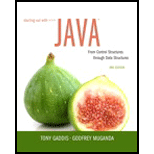
Starting Out with Java: From Control Structures through Data Structures (3rd Edition)
3rd Edition
ISBN: 9780134038179
Author: Tony Gaddis, Godfrey Muganda
Publisher: PEARSON
expand_more
expand_more
format_list_bulleted
Expert Solution & Answer
Chapter 15.8, Problem 15.25CP
Explanation of Solution
Display image using “ImageView” classes:
Displaying an image in JavaFx involves two steps, they are:
- Fetching image from the input stream or location.
- Displaying an image.
To perform these operations, JavaFx uses two classes, they are “Image” and “ImageView” classes.
- “Image” class is used to load graphical images, which can be displayed with the help of “ImageView” class.
- The package used for the image class is “javafx.scene.image.Image” which help to load the image from the URL or filename.
- It is possible to set one image to many “ImageView” because, one image can be displayed in multiple views. Whereas, it is not possible to display one “ImageView” multiple times because an “ImageView” node cannot be shared...
Expert Solution & Answer
Want to see the full answer?
Check out a sample textbook solution
Students have asked these similar questions
I need to define and discuss the uses of one monitoring or troubleshooting tool in Windows Server 2019. thank you
I would likr toget help with the following concepts:
- Windows Server features
- Windows Server versus Windows 10 used as a client-server network
I need to define and discuss the uses of one monitoring or troubleshooting tool in Windows Server 2019. thank you
Chapter 15 Solutions
Starting Out with Java: From Control Structures through Data Structures (3rd Edition)
Ch. 15.1 - What is a GUI?Ch. 15.1 - Prob. 15.2CPCh. 15.1 - Prob. 15.3CPCh. 15.1 - Prob. 15.4CPCh. 15.2 - Prob. 15.5CPCh. 15.2 - Prob. 15.6CPCh. 15.2 - Prob. 15.7CPCh. 15.2 - Prob. 15.8CPCh. 15.3 - Prob. 15.9CPCh. 15.3 - Prob. 15.10CP
Ch. 15.3 - Prob. 15.11CPCh. 15.4 - Prob. 15.12CPCh. 15.4 - Prob. 15.13CPCh. 15.4 - Prob. 15.14CPCh. 15.5 - Prob. 15.15CPCh. 15.5 - Prob. 15.16CPCh. 15.5 - Prob. 15.17CPCh. 15.6 - Prob. 15.18CPCh. 15.6 - Prob. 15.19CPCh. 15.6 - Prob. 15.20CPCh. 15.7 - Prob. 15.21CPCh. 15.7 - Prob. 15.22CPCh. 15.7 - Prob. 15.23CPCh. 15.8 - Prob. 15.24CPCh. 15.8 - Prob. 15.25CPCh. 15.9 - Prob. 15.26CPCh. 15.9 - Prob. 15.27CPCh. 15.9 - Prob. 15.28CPCh. 15.10 - Prob. 15.29CPCh. 15.10 - Prob. 15.30CPCh. 15.10 - Prob. 15.31CPCh. 15.10 - Prob. 15.32CPCh. 15 - Prob. 1MCCh. 15 - Prob. 2MCCh. 15 - Prob. 3MCCh. 15 - Prob. 4MCCh. 15 - Prob. 5MCCh. 15 - Prob. 6MCCh. 15 - Prob. 7MCCh. 15 - Prob. 8MCCh. 15 - The class to use when you want to represent an...Ch. 15 - Prob. 10MCCh. 15 - Prob. 11MCCh. 15 - If you use a lambda expression as an event...Ch. 15 - Prob. 13MCCh. 15 - Prob. 14MCCh. 15 - Prob. 15MCCh. 15 - Prob. 16MCCh. 15 - Prob. 17MCCh. 15 - Prob. 18MCCh. 15 - Prob. 19MCCh. 15 - Prob. 20MCCh. 15 - Prob. 1SACh. 15 - Prob. 2SACh. 15 - Prob. 3SACh. 15 - Prob. 4SACh. 15 - Prob. 5SACh. 15 - Prob. 6SACh. 15 - Prob. 7SACh. 15 - Prob. 8SACh. 15 - Prob. 9SACh. 15 - Prob. 10SACh. 15 - Checkerboard Write a program that takes a positive...
Knowledge Booster
Similar questions
- Please solve and answer the questions correctly please. Thank you!!arrow_forwardConsidering the TM example of binary sum ( see attached)do the step-by-step of execution for the binary numbers 1101 and 11. Feel free to use the Formal Language Editor Tool to execute it; Write it down the current state of the tape (including the head position) and indicate the current state of the TM at each step.arrow_forwardI need help on inculding additonal code where I can can do the opposite code of MatLab, where the function of t that I enter becomes the result of F(t), in other words, turning the time-domain f(t) into the frequency-domain function F(s):arrow_forward
arrow_back_ios
SEE MORE QUESTIONS
arrow_forward_ios
Recommended textbooks for you
 EBK JAVA PROGRAMMINGComputer ScienceISBN:9781305480537Author:FARRELLPublisher:CENGAGE LEARNING - CONSIGNMENT
EBK JAVA PROGRAMMINGComputer ScienceISBN:9781305480537Author:FARRELLPublisher:CENGAGE LEARNING - CONSIGNMENT Systems ArchitectureComputer ScienceISBN:9781305080195Author:Stephen D. BurdPublisher:Cengage Learning
Systems ArchitectureComputer ScienceISBN:9781305080195Author:Stephen D. BurdPublisher:Cengage Learning EBK JAVA PROGRAMMINGComputer ScienceISBN:9781337671385Author:FARRELLPublisher:CENGAGE LEARNING - CONSIGNMENT
EBK JAVA PROGRAMMINGComputer ScienceISBN:9781337671385Author:FARRELLPublisher:CENGAGE LEARNING - CONSIGNMENT New Perspectives on HTML5, CSS3, and JavaScriptComputer ScienceISBN:9781305503922Author:Patrick M. CareyPublisher:Cengage LearningProgramming Logic & Design ComprehensiveComputer ScienceISBN:9781337669405Author:FARRELLPublisher:Cengage
New Perspectives on HTML5, CSS3, and JavaScriptComputer ScienceISBN:9781305503922Author:Patrick M. CareyPublisher:Cengage LearningProgramming Logic & Design ComprehensiveComputer ScienceISBN:9781337669405Author:FARRELLPublisher:Cengage

EBK JAVA PROGRAMMING
Computer Science
ISBN:9781305480537
Author:FARRELL
Publisher:CENGAGE LEARNING - CONSIGNMENT

Systems Architecture
Computer Science
ISBN:9781305080195
Author:Stephen D. Burd
Publisher:Cengage Learning

EBK JAVA PROGRAMMING
Computer Science
ISBN:9781337671385
Author:FARRELL
Publisher:CENGAGE LEARNING - CONSIGNMENT


New Perspectives on HTML5, CSS3, and JavaScript
Computer Science
ISBN:9781305503922
Author:Patrick M. Carey
Publisher:Cengage Learning

Programming Logic & Design Comprehensive
Computer Science
ISBN:9781337669405
Author:FARRELL
Publisher:Cengage